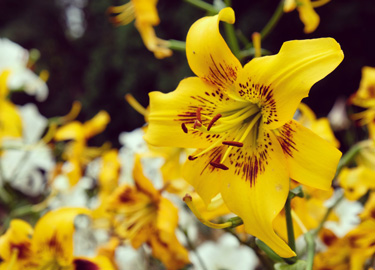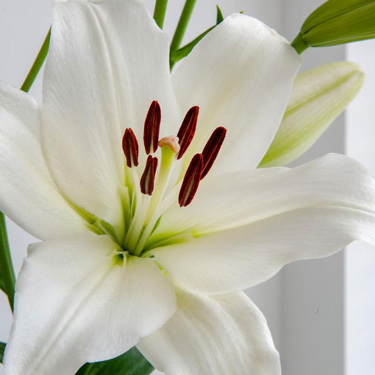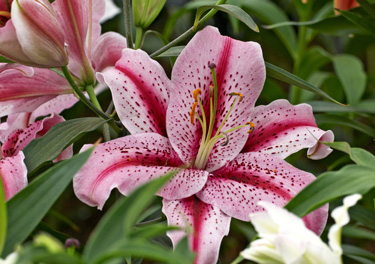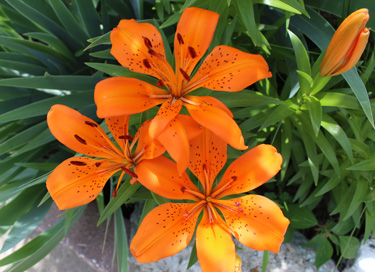Grow lilies
The sight of lilies blooming in a summer garden is enough to make anyone want to grow their own. The trick is to hold that thought until winter planting time comes around and the stunning array of carefully packaged bulbs arrives in garden centres. The lily planting season is short because, unlike other bulbs, they have no protective coat to prevent their bulbs from drying out.
In our gardens we grow daylilies, water lilies, calla lilies, canna lilies, spider lilies and rock lilies. All are beautiful in their own right but none bear any relationship to the true lilies. Grown in gardens for at least 3000 years, true lilies are the Lilium species and the countless hybrids breeders have created from them.
A favourite among the naturally occurring species, Lilium regale is known in New Zealand as the Christmas lily. This stunning plant is native to the Sichuan Province in southwestern China, where it grows wild on cliff faces. It was discovered there and introduced to England by the adventurous plant collector, Ernest Henry Wilson in 1903. This long- lived perennial grows 1 to 2 meters tall. Its large white trumpet flowers are flushed purple outside with a yellow throat and prominent yellow stamens. They’re strongly fragrant, especially at night
For a wider selection of colours and growth habits, today’s huge range of garden hybrids offer almost every colour, with compact lilies ideal for pots and taller forms great for picking. Oriental hybrids produce huge blooms up to 20cm across in combinations of pink, red and white. Their perfume will fill a room. Asiatic hybrids make up for their slightly smaller flowers with sheer volume of blooms and a wide range of hot colours.
It’s best to plant lily bulbs without delay, but they can be held in moist sand or peat moss until the scales become plump and roots start to sprout. The critical requirement is free draining garden soil or potting mix. Fortunately they will grow very well in containers if the garden soil isn’t ideal. While perfect drainage is essential, lilies also need constant moisture.
Lilies love sun but they prefer their roots to be kept cool under a blanket of mulch, or in the shade of other plants. They’ll push themselves up through other plants, following up the flush of spring flowering annuals and perennials with their striking summer display. Some varieties keep their colours better when grown in semi-shade.
Bulbs growing in free draining garden soil will multiply and can be left for 4 to 5 years before lifting and dividing. After flowering, allowing the foliage to die down naturally (rather than cutting it down) replenishes the bulb for the following year’s flowering. However, snapping of old flowers and seed heads will encourage healthy bulb growth.
Lily roots penetrate deep into the soil and they are hungry feeders. They will reward you with their very best flowering and healthy growth if you feed them well. Use a complete slow release fertiliser, such as Blood and Bone, at planting time and follow up with liquid feeding during spring.
If using animal manure, make sure it is well composted and don’t put it in the planting hole where it is in direct contact with the bulbs.
Lily checklist
- Plant without delay. Lily bulbs must not be allowed to dry out.
- Drainage is critical. Plant only in free drained soil or potting mix.
- Mulch to keep the soil cool and weeds out. Water thoroughly then apply a 5cm layer of compost or straw mulch.
- Feed them. Lilies are gross feeders.
- Hand weed only, without tools, to avoid damaging the bulb.
- For tall varieties, insert stakes at planting time to avoid bulb damage.
Growing lilies in pots
- Dwarf lily varieties are ideal for pots.
- Plant in good quality well drained potting mix, one Oriental lily to a 20cm diameter pot, or one dwarf or Asiatic lily to a 15cm pot.
- For tall varieties add a stake at planting time.
- Water regularly and feed with slow release fertiliser and liquid fertiliser.
- Bulbs in pots can be left for two years without repotting if fed with slow release fertiliser.

28-Jun-2020

Lily Yellow Bruse

Liliy Siberia

Lily Tiger Edition

Lily Orange Matrix

